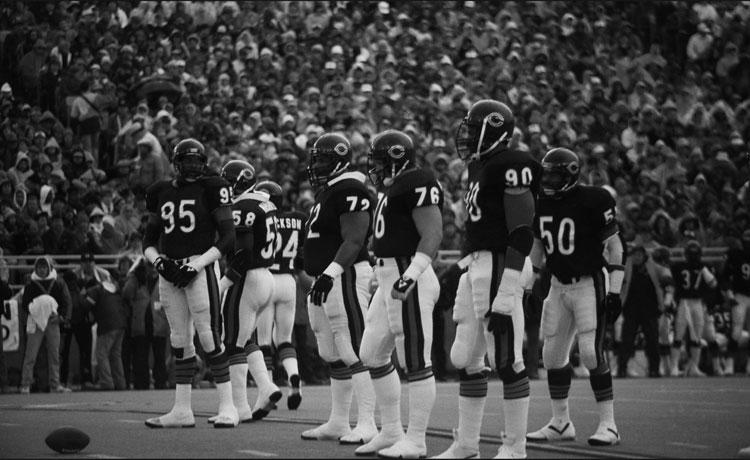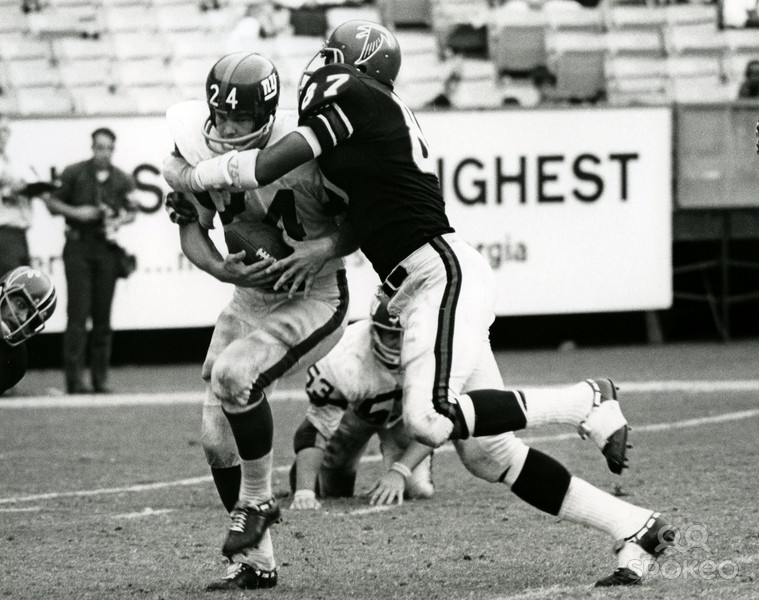Last week’s Flashback Friday declared the 2000 Ravens as the best defense of the 21st Century, but how do those Ravens stack up in the ranks of the greatest single-season defenses of all-time? Well I’m glad you asked, because that’s what we look at today. This study looks at and compares the defensive statistics of the 1976 Steelers, 1977 Falcons, 1985 Bears, and 2000 Ravens. Both the regular season and postseasons are taken into account.
Below are the straight-up, bare bones statistics of each respective defense, with the “best” number bolded with respect to each statistic:
*It should be noted that sacks were not considered an official stat until the 1982 season.
Right off the get-go, you can simply declare the 1977 Falcons as having the best defense of all-time, because they posted the fewest yards/game, points/game, and gave up fewer than 100 yards passing per game. Absurd numbers, for sure, but a study of this magnitude needs to dive deeper into those numbers.
 You could make the argument that the 1985 Bears were the most ferocious and best play-making defense ever, considering they had almost twice as many sacks as the 2000 Ravens and forced five more turnovers. But in terms of stopping opponents from scoring (which is the main purpose of a defense), they don’t quite match up with any of the other three defenses.
You could make the argument that the 1985 Bears were the most ferocious and best play-making defense ever, considering they had almost twice as many sacks as the 2000 Ravens and forced five more turnovers. But in terms of stopping opponents from scoring (which is the main purpose of a defense), they don’t quite match up with any of the other three defenses.
The ’85 Bears did post the greatest defensive postseason of all-time, however, giving up only 3.3 points/game and 145 yards/game during their run to the Super Bowl. That bests the 2000 Ravens’ numbers of 5.8 points/game and 209 yards/game. But in terms of their entire season, the numbers don’t stack up. Thus, the 1985 Bears have been eliminated from the rest of this study, as their numbers are statistically worse in terms of yards/game and points/game than the remaining three teams.
This next section takes the opposing offenses into consideration. How many top offenses did each defense face? How different were the numbers in those games compared to the entire season as a whole?
Out of the 20 games the 2000 Ravens played (16 reg. season, four postseason), they played eight against teams with offenses in the top half of the league (40%). In the following chart, the top line shows the overall numbers in the 16 regular season games (the same as what is seen above). The second line shows the defensive numbers in those eight games against the top-tier offenses.
The defensive numbers were worse against the top offenses, but that should be expected. They gave up 13.25 points/game in those eight games when compared to the 10.3 they gave up on average for the entire season (a 22.2% increase), and roughly 13 more yards per game. So, while there is a difference, that difference is rather small. This hurts the argument that the 2000 Ravens defense benefited from  playing weak offenses and helps build the case for the Ravens defense being one of the best of all-time, as they held the top offenses in check just about as well as they did everyone else that year.
playing weak offenses and helps build the case for the Ravens defense being one of the best of all-time, as they held the top offenses in check just about as well as they did everyone else that year.
The Ravens franchise holds the distinction of never allowing more than 4.0 yards/carry, on average, in any season in the team’s 19 year history. The 2000 defense gave up fewer than 3.0 yards per carry for the entire season (2.9). It’s undebatable that the 2000 Ravens had the best rush defense in the history of the NFL.
Now let’s look at the 1976 Steelers in the same way. It is worth mentioning that overall the ’76 Steelers gave up fewer yards/game and points/game than the 2000 Ravens (chart 1).
Out of the 16 games the 1976 Steelers played (14 reg. season, two postseason), 10 were against the top half of the league (62.5%). That number is higher than the 2000 Ravens (40%). That fact, however, should not count against the Ravens, who had no control over who was on their schedule. That is why this analysis takes into account the stats against the top offenses faced.
When facing offenses in the top half of the league, the Steelers gave up 15.7 points/game, compared to the 9.85 points/game they gave up on the season. That’s a 63% increase, which is far worse than the 22.2% increase by the 2000 Ravens defense. They ’76 Steelers also gave up 34 more yards/game against top tier offenses, which is worse than the 13-yard increase of the Ravens. This insight shouldn’t be the only thing considered, but it just about kills the argument that the 2000 Ravens shouldn’t be considered the best simply because they played against worse offenses.
While the 1976 Steelers may have faced more top-tier offenses, they also faced some of the worst offenses in the history of the league in the Tampa Bay Buccaneers and New York Giants. The 1976 Buccaneers averaged only nine points/game and an abysmal 214 yards/game that season. They scored 20 points only once all season and were shutout in over one-third of their games.
Oh, and they went 0-14.
 The ’76 Steelers failed to even reach the Super Bowl after giving up 24 points to the Raiders in the playoffs. That’s more points than the 2000 Ravens gave up combined in their four playoff games that entire postseason.
The ’76 Steelers failed to even reach the Super Bowl after giving up 24 points to the Raiders in the playoffs. That’s more points than the 2000 Ravens gave up combined in their four playoff games that entire postseason.
It’s very, very close, but the 2000 Ravens have to be given the nod over the 1976 Steelers.
The 3rd and final defense we shall look at is the 1977 Atlanta Falcons. If the 2000 Ravens had the best rushing defense ever, it could very well be argued that the ’77 Falcons had the best pass defense ever, giving up, on average, less than 100 yards per game. Think about that for a second. Less than 100 yards per game. Sure, they played in the dead ball era when passing offenses pale in comparison to today’s era, but that’s still quite an accomplishment.
Out of the 14 regular season games the Falcons played that year (they did not qualify for the playoffs) only four games were against top-tier offenses (28%).
Nevertheless, the Falcons gave up 13.75 points/game in those four games, compared to 9.2 overall on the season (a 33% increase).
The chart below shows how each team fared against the top-tier offenses from each respective season:
When facing the top offenses from their respective seasons, the 2000 Ravens gave up the fewest yards/game, points/game, and rush yards/game. But looking back at the first chart, the 1976 Steelers had the most impressive numbers considering they faced more top-tier offenses. But they also played in the dead ball era, when passing attacks were nowhere near what they are nowadays.
So many contributing factors to consider.
Taking everything into account, however, this would be my list of the top 5 single-season defenses of all-time:
- 2000 Baltimore Ravens (best rush defense of all-time, best overall defense)
- 1976 Pittsburgh Steelers
- 1985 Chicago Bears (best play-making defense of all-time, best postseason defense of all-time)
- 1977 Atlanta Falcons (best pass defense of all-time)
- 2013 Seattle Seahawks (see last week’s article)
It is difficult to weigh all the contributing factors, especially when looking at statistics from different eras. The case for the 1976 Steelers being better than the 2000 Ravens is certainly debatable, but there is more credibility for backing the Ravens. This was my crack at explaining why. The Chicago Bears didn’t quite stack up during the regular season in terms of their yardage and points given up per game. They were the best ever in the postseason, however, leading the Bears to a combined 18-1 record and a Super Bowl. They also racked up 64 sacks. This puts them higher than the 1977 Falcons overall.
Have a different opinion? Please feel free to share. I’d love to hear from you in the comments section. You can also reach me on twitter @bakerspazing.
[cardoza_wp_poll id=”1352″]












